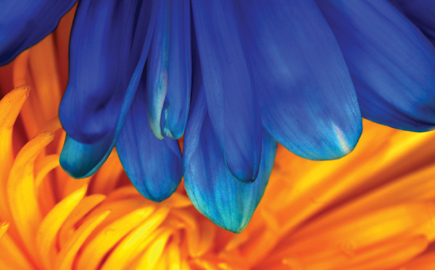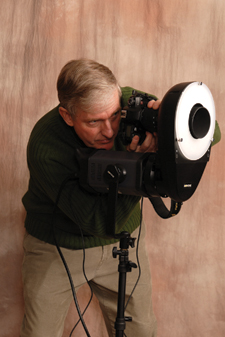Bowens’ RingLite Converter; Get The “Ringlight Look” On A Budget
I've always been envious of those great looks that fashion photographers get with the use of expensive ringlights. Now along comes Bowens with the promise of a ringlight at a much lower price (approx. $450). Until now, you basically had two choices when it came to ringlights. You could buy tiny, low-powered units that sit around your lens, great for macro work such as florals or for taking pictures of postage stamps. Or you could buy a big, high-powered light with its own generator, cords, and connecting equipment; I've seen them for as much as $2500. So what Bowens has tried to do is make a converter to convert its popular monobloc flash units into a ringlight.
 |
|
|
When I received the box in the mail and opened it up I said, "Wow, this
is quite a contraption." You can call it a converter or an adapter, but
basically what the RingLite Converter does is mount on the front of a Bowens
light unit and turn it into a ringlight. What came in the box was a converter
and a couple of mounting brackets. The brackets allow you to mount your camera
so that the lens lines up and shoots through the ringlight. The first bracket
allows for horizontal or landscape shooting; the second bracket is an adapter
to allow for vertical or portrait shooting. I immediately attached the Bowens
light unit to a light stand, attached the converter to the Bowens light, and
then attached the mounting bracket for the camera. After shooting in both the
horizontal and vertical positions with the brackets, I found it was much easier
for me to just forget about the brackets and poke
my lens through the hole in the ringlight and shoot.
Here's how it works: You attach the adapter to the front of the flash
unit. The light from the flash tube is reflected up into the ringlight unit.
The reflected light is then projected through the Plexiglas-looking ringlight.
There is a catch, though. The modeling light sticks out too far to be left on
when using the converter. So before you can mount the converter, you must remove
the modeling light. What this means is that you are essentially shooting blind!
It's not quite the handicap you might think. Remember, you're taking
photos through the center of the ringlight, so the light is always coming directly
from camera position. This also means that working in the studio will be working
with the room lights on.
 |
|
|
Let's see what that means in real-life shooting situations. I tested
the RingLite Converter in three different situations, shooting photos with a
model, jewelry, and some flowers.
First up was the model. It seemed kind of strange at first shooting with no
modeling lights. If you are shooting film that can be a real issue, but at least
with digital you can look at the results immediately and see what's happening.
As you can see by the accompanying photo, it's a little awkward using
the device. I finally gave up on the brackets and ended up just poking my camera
through the center hole, which made it easier for me to quickly switch between
horizontal and vertical positions. Shooting with a ringlight pretty much requires
using a zoom lens. That's because if you try to move the whole rig, you're
going to keep changing the exposure. It makes more sense to just nail down your
exposure at a certain distance and use your zoom lens to control the image size.
One issue did come to the fore: even though I had room lights on in my studio,
redeye was a major problem. I'd suggest if you want to use this in the
studio that you turn on your brightest modeling lights and aim them at your
subject to reduce any redeye issues.
 |
After using the ringlight for model photography, I turned to jewelry. You
may think the ringlight is a good choice for jewelry photography. That may be
the case if you are photographing something flat. The reason is that when you
photograph a piece of jewelry, you usually want to control the light to pick
up the different facets of the piece. With the ringlight aimed right at the
jewelry, unless the surface is flat, you are probably going to pick up some
unwanted reflections. I gave it a shot, but there are better options when photographing
jewelry.
































